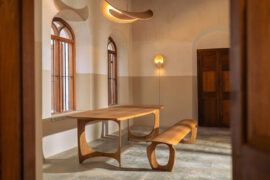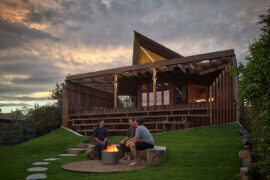We look back at last month’s Archifest Forum and select some key points from the panel discussion.

November 15th, 2012
This year’s Archifest forum occurred on 17 October at SOTA, and served to dissect and discuss the overarching Archifest 2012 theme of ’Rethink Singapore’. The speakers were Winy Maas (MVRDV), Steven Fleming (University of Tasmania), Erieta Attali (Columbia University), Andres Sevtsuk (Singapore Universty of Technology and Design and City Form Lab), Leonard Ng (Atelier Dreseitl), Khoo Peng Beng (ARC Studio), Goh Sze Ying (Popdigital), and Tai Lee Siang (Ong&Ong). Kelley Cheng (The Press Room) moderated the proceedings.

Kelley Cheng on change and community:
“Right now, Singapore is going through massive change. For most of us who have lived luxuriously in a country that used to have 2.58 million people, today’s 5.8 million means a lot of change in a very short time. As [Singapore Institute of Architects President] Theodore [Chan] mentioned in a recent interview, since last year’s election there’s been this rise of the community in order for people to cope. And with social media, Singaporeans are more vocal these days.
“Creativity thrives on freedom – of thought, speech and action. With social media, I think Singaporeans are starting to find creativity because we finally have a platform on which to speak up.”

Andres Sevtsuk on rapid change:
“The degree to which people are happy with change largely depends on the rate of change – how quickly change happens. Over and over again in other countries we see that if change is very rapid, it’s hard to get used to.”

Khoo Peng Beng on boundaries:
“The thing about rules is that once you start to make them, you can’t stop. Now our handrails are being governed. But if someone wants to jump, they’ll jump right? You have to learn that if you’re not careful, you’ll fall. We need to find a kind of balance between setting very tight boundaries and having no room to manoeuvre, versus having developmentally oriented boundaries. What kind of boundaries do we need?”

Tai Lee Siang on green density:
“What we hear people complaining about with regard to ’6 million people’ sometimes has nothing to do with hardware. A lot of it is emotional and to do with social distance, and Singaporeans not knowing how to cope with foreigners living under the same roof. Lets put all those things aside, and ask ourselves as architects and planners: assuming all people are nice to each other, can we decently house 6 million people within 700sqkm?
“Looking at Peng Beng’s model, and looking at what we have today, I think we can. My argument against it has to do with our adaptation to high-density living. We have now begun to accept that we can live in shoebox apartments. But is that humane? And if not, what should really be done? What is the right proportion of green space versus the dwelling space that a human being should rightfully deserve to have?
“I suspect we still fall short. We don’t just need to pump in people; we need to pump in the green as well. And when we achieve that, I think we’ll be a shining model. That’s something I’m dying to see!”

Erieta Attali on visualising the city:
“Let’s say the URA invited photographers from different parts of the world – places where people are completely disconnected from the concept of what is an Asian city is like – and let them photograph different parts of Singapore. Then exhibit the results and let Singaporeans see what their city looks like from the foreigner’s point of view. It would be interesting to see.”

Andres Sevtsuk on building for diversity:
“An area that I’m very interested in thinking about in Singapore is the role of building typologies. There are building types that can accommodate – better or worse – diversity in them. Historically there are lots of great examples – the Haussman type in Paris, or the row house in London, or the Dutch row house. In Singapore, we’ve had the shophouse.
“There are currently some interesting types of blocks being built that have very high density upstairs while still forming streets. That could be one area of research that’s helpful – to think very seriously about building types. How can we implement building types that lend themselves more readily to accommodating diverse uses? And even if those uses are not there right now, the buildings are ready to be adapted at some point in time.”

Archifest 2012
archifest.sg
INDESIGN is on instagram
Follow @indesignlive
A searchable and comprehensive guide for specifying leading products and their suppliers
Keep up to date with the latest and greatest from our industry BFF's!

For Aidan Mawhinney, the secret ingredient to Living Edge’s success “comes down to people, product and place.” As the brand celebrates a significant 25-year milestone, it’s that commitment to authentic, sustainable design – and the people behind it all – that continues to anchor its legacy.
The new range features slabs with warm, earthy palettes that lend a sense of organic luxury to every space.

Don’t miss 2021’s most anticipated architecture and design knowledge symposium! Taking off next Thursday 5 August. Register for your FREE ticket today.

You can probably count on one hand, the number of firms that have exported design services from New Zealand into Australia. Firms like Warren and Mahoney, whose ‘one studio’ approach has made it possible to grow exponentially, while still running a tight, talent-rich team.
The internet never sleeps! Here's the stuff you might have missed

From Australian architects to Spanish and Indian designers, Design Mumbai 2025 expands its international reach — proving India’s growing role on the global design stage.

CPD Live returns for its final live-presented season of 2025, bringing architects, designers, and specifiers a free opportunity to earn CPD points before the year ends. Kicking off at 9 AM AEDT, This Tuesday 14th October.

Carr’s largest residential project to date integrates concrete, steel mesh and landscape across 122 apartments in Melbourne’s Brunswick.

Recognised as a winner at the INDE.Awards 2025, Barton Taylor has received The Photographer – Residential accolade. His photographic work on Cake House captures the soul of a coastal icon reimagined, blending light, texture and atmosphere into a compelling visual narrative.